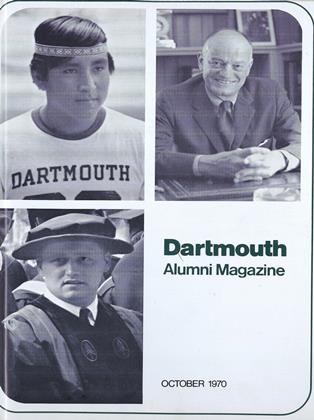By Albert NathanielDrake ’43. Los Altos Hills (Calif.). Privately printed, 1970. 159 pp. $4.50.
“I can’t drink wine,” says the four-to-one martini man after his third cocktail. “It upsets my digestion.” “Wine is the most healthful and most hygienic of beverages,” says Louis Pasteur, the world-famous chemist, and the Bible advises one to drink one’s wine with a merry heart. “May I see the wine list, please?”, heard ever more frequently in the United States, indicates that many Americans having dined in Europe and succumbed to vinous delights return home with a new esthetic interest.
Mr. Drake has discovered that the drinking of wine is not only a pleasure; it is big business. In London recently $480 was paid for a double magnum of Chateau Lafite 1865, presumably the highest price ever paid for a single bottle of red Bordeaux anywhere in the world. Thus, an ounce would run to about $5 and a sip to $2.50, Bidding in absentia, a London surgeon paid $1,100 for a single case of French sauternes, dating back to 1912. At a recent auction in Chicago, sponsored by Heublein, Inc., more than $106,000 was realized for wines dating back to the ninteenth century.
Such figures fascinated a business entre- preneur of Los Altos Hills, Mr. Drake, and in April 1969 he turned his inquiring mind to the possibilities of Californian wines as an investment. During eight months of intensive “research,” he drank wine, borrowed exten- sively from authoritative technical sources, sought help from the Wine Institute, and wrote Wine and You, notable for its factual approach. It is, in effect, a reference book with figures, charts, maps, pictures, and hard-headed exposition.
No Californian bigot, Mr. Drake admits that the great wines of his state are few in number, and so they are in all wine- producing countries. California has only five great whites: Gewiirztraminer, Semilion, Sauvignon Blanc, White Riesling (Johannis- burg Riesling), and Pinot Chardonnay. And even fewer great reds: Zinfandel, Pinot Noir, and Cabernet Sauvignon.
Should you wish to invest in a ten acre- vineyard, after you had bought suitable land costing from $6OOO to $20,000 an acre, Mr. Drake figures that your total cash flow would be $12,821 the first year; $3,660 the second; and $2,170 the third. By the fourth year you might make a small profit and a handsome one, $39,180, by the end of your tenth, provided you are still alive after hard work, labor problems, and multiple frustra- tions.
Would it not be easier to make money with a modest wine cellar? Yes. Here’s how. Buy 200 bottles a year for ten years of young-in-bottle Cabernet Sauvignon at $3. After ten years your investment of only $6,000 will attain a value of $40,000. Warning: you cannot cash in on your profits; you can only drink them.
 View Full Issue
View Full Issue
More From This Issue
-
 Cover Story
Cover StoryLiberating the Ph.D.
October 1970 By Robert B. Graham ’40 -
 Feature
FeatureEleazar Is Outdone
October 1970 By Charles Jay Kershner -
 Feature
FeatureThe Dickeys Get Resettled
October 1970 -
 Article
ArticleDear Mr. Cunningham . . .
October 1970 -
 Article
ArticleFaculty
October 1970 By William R. Meyer -
 Sports
SportsBig Green Teams
October 1970 By Jack DeGange
John Hurd ’21
Books
-
 Books
Books"Wholesome Marriage"
NOVEMBER 1927 -
 Books
BooksEskimo Culture
MARCH 1983 By Elmer Harp Jr. -
 Books
BooksJOURNALISM AND THE STUDENT PUBLICATION
June 1952 By Eric P. Kelly '06 -
 Books
BooksOWEN GLEN
October 1950 By Herbert F. West '22 -
 Books
BooksTHE ANATOMY LESSON AND OTHER STORIES.
July 1957 By ROBERT Y. TURNER -
 Books
BooksALGEBRA
MARCH 1967 By WILLIAM R. COGSWELL '61





